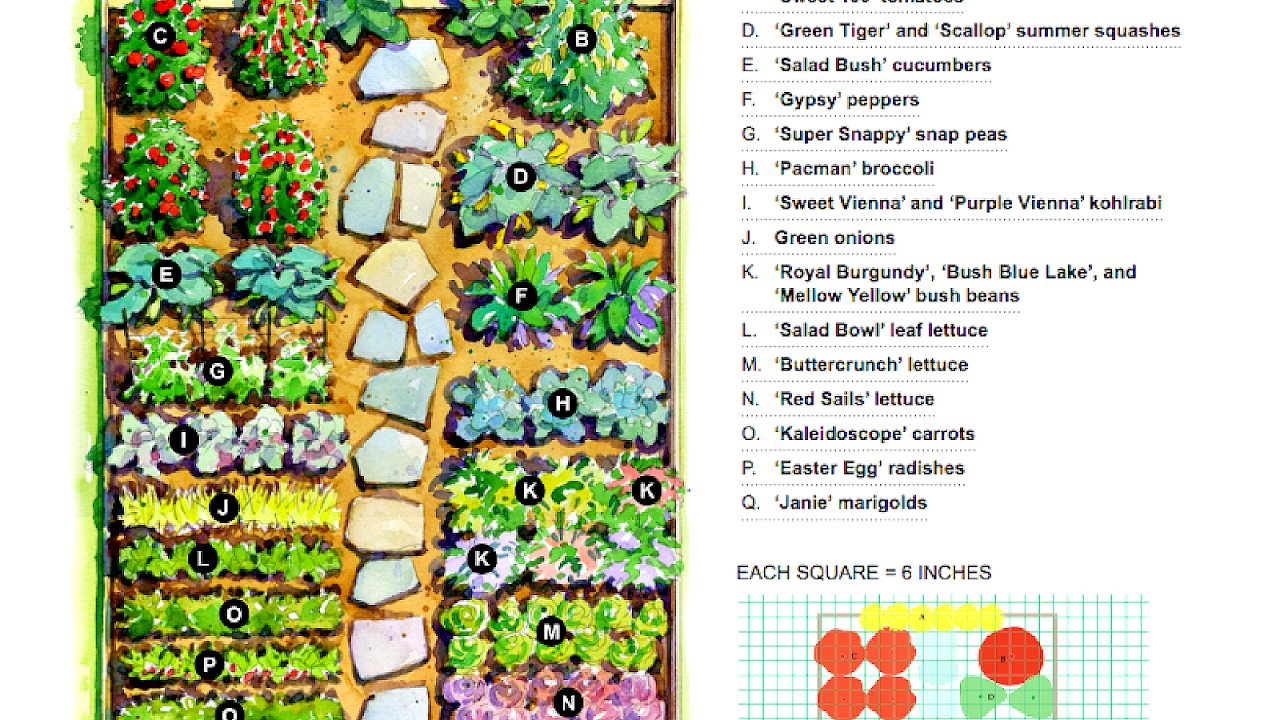
The traditional kitchen garden, also known as a potager (in French, jardin potager) or in Scotland a kailyaird, is a space separate from the rest of the residential garden - the ornamental plants and lawn areas. Most vegetable gardens are still miniature versions of old family farm plots, but the kitchen garden is different not only in its history, but also its design.
The kitchen garden may serve as the central feature of an ornamental, all-season landscape, or it may be little more than a humble vegetable plot. It is a source of herbs, vegetables and fruits, but it is often also a structured garden space with a design based on repetitive geometric patterns.
The kitchen garden has year-round visual appeal and can incorporate permanent perennials or woody shrub plantings around (or among) the annuals.

Maps, Directions, and Place Reviews
Potager garden
A potager is a French term for an ornamental vegetable or kitchen garden. The historical design precedent is from the Gardens of the French Renaissance and Baroque Garden à la française eras. Often flowers (edible and non-edible) and herbs are planted with the vegetables to enhance the garden's beauty. The goal is to make the function of providing food aesthetically joyful.
Plants are chosen as much for their functionality as for their color and form. Many are trained to grow upward. A well-designed potager can provide food as well as cut flowers and herbs for the home with very little maintenance. Potagers can disguise their function of providing for a home in a wide array of forms--from the carefree style of the cottage garden to the formality of a knot garden.
Vegetable Garden Planner Video
Vegetable garden
A vegetable garden (also known as a vegetable patch or vegetable plot) is a garden that exists to grow vegetables and other plants useful for human consumption, in contrast to a flower garden that exists for aesthetic purposes. It is a small-scale form of vegetable growing. A vegetable garden typically includes a compost heap, and several plots or divided areas of land, intended to grow one or two types of plant in each plot. Plots may also be divided into rows with an assortment of vegetables grown in the different rows. It is usually located to the rear of a property in the back garden or back yard. Many families have home kitchen and vegetable gardens that they use to produce food. In World War II, many people had a "victory garden" which provided food and thus freed resources for the war effort.
With worsening economic conditions and increased interest in organic and sustainable living, many people are turning to vegetable gardening as a supplement to their family's diet. Food grown in the back yard consumes little if any fuel for shipping or maintenance, and the grower can be sure of what exactly was used to grow it. Organic horticulture, or organic gardening, has become increasingly popular for the modern home gardener.

Herb garden
The herb garden is often a separate space in the garden, devoted to growing a specific group of plants known as herbs. These gardens may be informal patches of plants, or they may be carefully designed, even to the point of arranging and clipping the plants to form specific patterns, as in a knot garden.
Herb gardens may be purely functional or they may include a blend of functional and ornamental plants. The herbs are usually used to flavour food in cooking, though they may also be used in other ways, such as discouraging pests, providing pleasant scents, or serving medicinal purposes (such as a physic garden), among others.
A kitchen garden can be created by planting different herbs in pots or containers, with the added benefit of mobility. Although not all herbs thrive in pots or containers, some herbs do better than others. Mint, a fragrant yet invasive herb, is an example of an herb that is advisable to keep in a container or it will take over the whole garden.
Culinary herbs in temperate climates are to a large extent still the same as in the medieval period. Herbs often have multiple uses. For example, mint may be used for cooking, tea, and pest control. Among the many uses of herbs are:
- Annual culinary herbs: basil, dill, summer savory
- Perennial culinary herbs: mint, rosemary, thyme, tarragon, sage
- Herbs used for potpourri: lavender, lemon verbena
- Herbs used for tea: mint, lemon verbena, chamomile, thyme, bergamot, hibiscus
- Herbs used for other purposes: stevia for sweetening, feverfew for pest control in the garden.
Witches' garden
A witches' garden is an herb garden specifically designed and used for the cultivation of herbs, for culinary, medicinal and/or spiritual purposes. Herbal baths, the making of incense, tied in bundles for rituals or prayers, or placed in charms are just some of the ways herbs can be used for spiritual purposes.
Herb gardens developed from the general gardens of the ancient classical world, which were used for growing vegetables, flowers, fruits and medicines. For centuries "wise women" and "healers" understood the uses of herbs for the purposes of healing and magic. During the medieval period, monks and nuns acquired this medical knowledge and grew the necessary herbs in specialised gardens.
Typical plants in a witches' garden are: rosemary, sage, parsley, mint, catnip, henbane, marjoram, thyme, rue, angelica, bay, oregano, dill, aloe, arnica, chives, and basil. Basil is especially common in these gardens as a strong protection herb. It is said, "Where basil grows, no evil goes!" and "Where basil is, no evil lives!"
Source of the article : Wikipedia


EmoticonEmoticon